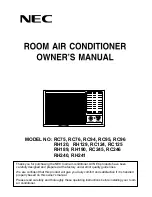
SCS C
ONDENSER
IOM
M
ANUAL
11
condenser with consideration to elevation changes. Each
valve, fitting and bend in the refrigerant line must also be
considered in this calculation. Refer to Table 3 for standard
equivalent lengths, in feet, of straight pipe.
Table 3. Pipe Equivalent Lengths
Refer to the installation manual provided with the A/C system for
tables showing the recommended liquid line and discharge line
sizes for the A/C system you are installing.
Things to consider when sizing refrigerant piping are the varying
BTU capacities of indoor evaporators and the equivalent length
of pipe needed between the remote condenser and the
evaporator.
If the pressure drop is too high, the capacity of the compressor
decreases, and the power required increases. An excessive
refrigerant charge will be applied if the volume of the piping is too
large. Refrigerant line sizing for discharge and liquid lines should
create no more than a 2–3 °F pressure drop (1 °F = 4.75 psi).
NOTE: The size of the condenser pipe connections does not
indicate the size of the refrigerant lines to be used. In cases where
the pipe size doesn’t match the size of the connection, reducing
fittings must be used to transition between the connection and
the pipe.
2.5.1.1
Discharge Line
Since refrigerant may condense during “Off” cycles, all vertical
discharge risers should be designed to prevent liquid
refrigerant from flowing back into the compressor. If a
condenser is installed above the evaporator, the discharge line
should include a shallow P-trap at the lowest point in the piping
(see Figure 8).
The highest point in the discharge line should be above the
condenser coil. Install an inverted trap at the condenser inlet to
prevent liquid refrigerant from flowing backwards into the hot
gas riser during off cycles. Shallow P-traps must be included in
the discharge line for every 20 feet of vertical rise. All horizontal
refrigerant lines should be pitched in the direction of flow at
least 1/4” per 10 feet.
Discharge line velocities must be a minimum of 500 fpm for
horizontal runs and 1,000 fpm for vertical risers to ensure oil is
returned to the compressor at both full and partial load
operating conditions.
It’s important that the discharge line is sized with a certain
degree of pressure drop. This will ensure the refrigerant flows at
a velocity high enough for the refrigerant vapor to carry the oil
with it to the condenser and to prevent the oil from returning to
the compressor.
Compressor discharge pressure is always higher than
condensing pressure due to the line pressure drop. The line
pressure drop also causes a change in the refrigerant saturation
temperature. The discharge line needs to be sized so the
pressure drop won’t cause a corresponding change in saturation
temperature exceeding 2 °F.
Discharge piping is typically sized for a total line pressure drop
of 5 psi (+/- 50%), which results in only a 1/2% to 1% reduction
in compressor capacity. Pressure drops greater than 10 psi will
impair system performance.
Figure 8 depicts a typical piping diagram when the condenser is
located at a higher level than the indoor evaporator. In this
situation, it’s especially important to size the discharge line
properly. If the discharge line is sized correctly for full load
operation, the velocity of the gas may be too low during
minimum load conditions to carry the refrigerant oil vertically
through the discharge line to the condenser coil.
Decreasing the size of the discharge line will increase the
refrigerant velocity, however, it will also restrict the flow of
refrigerant at full load conditions creating an excessive
refrigerant pressure drop.
To remedy this, dual risers may be used as shown in Figure 9
Discharge riser #1 should be sized to allow the refrigerant gas to
flow at a sufficient velocity during minimum load conditions to
carry the oil.
Riser #2 should be sized in such way that the inside diameter of
riser #1 and #2 will together have a combined area allowing for
a flow velocity that’s suitable to carry the refrigerant oil to the
condenser during peak load conditions.
Use a trap between the 2 risers so riser #2 will be sealed off
when the trap fills with oil during partial load operation, thus
diverting the flow of refrigerant to riser #1.
Equivalent Length (ft) of Straight Pipe
OD (In.)
Line Size
Globe
Valve
Angle
Valve
90º
Elbow
45º
Elbow
Tee
Line
Tee
Branch
1/2
9.0
5.0
0.9
0.4
0.6
2.0
5/8
12
6.0
1.0
0.5
0.8
2.5
7/8
15
8.0
1.5
0.7
1.0
3.5
1-1/8
22
12
1.8
0.9
1.5
4.5
1-3/8
28
15
2.4
1.2
1.8
6.0
1-5/8
35
17
2.8
1.4
2.0
7.0
2-1/8
45
22
3.9
1.8
3.0
10
















































